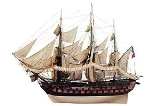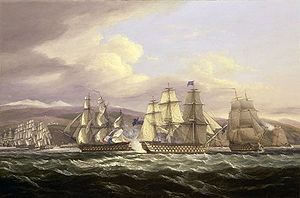
French ship Scipion
Encyclopedia
Scipion was a 74-gun French
ship of the line
, built at Lorient to a design by Jacques Noel Sane. She was launched as Orient in late 1798, and renamed Scipion in 1801.
She was first commissioned in 1802 and joined the French Mediterranean fleet based at Toulon
, in the squadron of Admiral Leissègues
. Consequently she was one of the ships ships afloat in that port when war with England reopened in May 1803.
's fleet. She took part in the Battle of Cape Finisterre
, and was one of the ships of Vice Admiral Pierre Dumanoir le Pelley
at the Battle of Trafalgar
.
Dumanoir commanded the six ship vanguard of the French fleet, with Formidable
, Scipion
, Duguay-Trouin
, Mont-Blanc
, Intrépide
and Neptune
. Nelson
's attacks left these ships downwind of the main confrontation and Dumanoir did not immediately obey Villeneuve
's orders to return to the battle. When the ships did turn back, most of them only exchanged a few shots before retiring.
On 4 November 1805, in the Battle of Cape Ortegal
, British Admiral Sir Richard Strachan
, with Caesar, Hero, Courageux, Namur and four frigates, defeated and captured what remained of the squadron. HMS Phoenix
and Révolutionnaire
took Scipion, which the Royal Navy
commissioned as HMS Scipion.
She became the flagship of Rear Admiral the Hon. Robert Stopford in 1810. Bateman and Stopford sailed her in the Bay of Biscay.
On 8 October she sailed for the Cape of Good Hope
and then the East Indies
. In 1811 Capt. James Johnson took command. Stopford's fleet consisted of four sail of the line (including Scipion), thirteen frigate
s, seven sloops and eight cruisers of the East India Company
, captured the island of Java on 18 September 1811. In 1847, the surviving members of the expedition were awarded the Naval General Service Medal with clasp "JAVA".
 Capt. Henry Hearthcote took command on 28 April 1812. He then sailed Scipion for the Mediterranean on 20 July 1812. Here she participated in the blockade of Toulon, including Admiral Edward Pellew's skirmish with the French fleet on 5 November 1813.
Capt. Henry Hearthcote took command on 28 April 1812. He then sailed Scipion for the Mediterranean on 20 July 1812. Here she participated in the blockade of Toulon, including Admiral Edward Pellew's skirmish with the French fleet on 5 November 1813.
France
The French Republic , The French Republic , The French Republic , (commonly known as France , is a unitary semi-presidential republic in Western Europe with several overseas territories and islands located on other continents and in the Indian, Pacific, and Atlantic oceans. Metropolitan France...
ship of the line
Ship of the line
A ship of the line was a type of naval warship constructed from the 17th through the mid-19th century to take part in the naval tactic known as the line of battle, in which two columns of opposing warships would manoeuvre to bring the greatest weight of broadside guns to bear...
, built at Lorient to a design by Jacques Noel Sane. She was launched as Orient in late 1798, and renamed Scipion in 1801.
She was first commissioned in 1802 and joined the French Mediterranean fleet based at Toulon
Toulon
Toulon is a town in southern France and a large military harbor on the Mediterranean coast, with a major French naval base. Located in the Provence-Alpes-Côte-d'Azur region, Toulon is the capital of the Var department in the former province of Provence....
, in the squadron of Admiral Leissègues
Corentin Urbain Leissègues
Corentin Urbain de Leissegues was a French admiral of the Napoleonic wars, notably protagonist of the Battle of San Domingo.- Biography :...
. Consequently she was one of the ships ships afloat in that port when war with England reopened in May 1803.
French Navy service
In 1805, she was part of Admiral VilleneuvePierre-Charles Villeneuve
Pierre-Charles-Jean-Baptiste-Silvestre de Villeneuve was a French naval officer during the Napoleonic Wars. He was in command of the French and Spanish fleets defeated by Nelson at the Battle of Trafalgar....
's fleet. She took part in the Battle of Cape Finisterre
Battle of Cape Finisterre (1805)
In the Battle of Cape Finisterre off Galicia, Spain, the British fleet under Admiral Robert Calder fought an indecisive naval battle against the Combined Franco-Spanish fleet which was returning from the West Indies...
, and was one of the ships of Vice Admiral Pierre Dumanoir le Pelley
Pierre Dumanoir le Pelley
Vice-Admiral Count Pierre-Etienne-René-Marie Dumanoir Le Pelley was a French Navy officer, best known for commanding the vanguard of the French fleet at the Battle of Trafalgar.- Early career :...
at the Battle of Trafalgar
Battle of Trafalgar
The Battle of Trafalgar was a sea battle fought between the British Royal Navy and the combined fleets of the French Navy and Spanish Navy, during the War of the Third Coalition of the Napoleonic Wars ....
.
Dumanoir commanded the six ship vanguard of the French fleet, with Formidable
French ship Formidable
A number of ships of the French Navy have born the name Formidable, honouring the trait of inspiring fear in the enemy. Among them:* Formidable , a 96-gun ship of the line* Formidable , a 80-gun ship of the line...
, Scipion
French ship Scipion
Scipion was a 74-gun French ship of the line, built at Lorient to a design by Jacques Noel Sane. She was launched as Orient in late 1798, and renamed Scipion in 1801....
, Duguay-Trouin
HMS Implacable (1805)
HMS Implacable was a 74-gun third rate of the Royal Navy. She was originally the French Navy's Téméraire-class ship of the line Duguay-Trouin, launched in 1800....
, Mont-Blanc
French ship Mont-Blanc (1791)
Mont-Blanc was a 74-gun third-rate ship of the line of the French Navy.She was built at Rochefort as Pyrrhus in 1791. She was renamed Mont-Blanc in 1793 before being renamed Trente-et-un Mai in 1794. Under that name she fought at the Battle of the First of June in June 1794 under Honoré Joseph...
, Intrépide
French ship Intrépide
Intrépide was a 74-gun third-rate ship of the line of the French navy. She was originally built at Ferrol, Spain in 1799 as the Spanish ship of the line Intrepido, and later was sold to France in 1800....
and Neptune
French ship Neptune
Neptune was a Bucentaure-class 80-gun ship of the line of the French Navy. Built during the last years of the French Revolutionary Wars she was launched at the beginning of the Napoleonic Wars...
. Nelson
Horatio Nelson, 1st Viscount Nelson
Horatio Nelson, 1st Viscount Nelson, 1st Duke of Bronté, KB was a flag officer famous for his service in the Royal Navy, particularly during the Napoleonic Wars. He was noted for his inspirational leadership and superb grasp of strategy and unconventional tactics, which resulted in a number of...
's attacks left these ships downwind of the main confrontation and Dumanoir did not immediately obey Villeneuve
Pierre-Charles Villeneuve
Pierre-Charles-Jean-Baptiste-Silvestre de Villeneuve was a French naval officer during the Napoleonic Wars. He was in command of the French and Spanish fleets defeated by Nelson at the Battle of Trafalgar....
's orders to return to the battle. When the ships did turn back, most of them only exchanged a few shots before retiring.
On 4 November 1805, in the Battle of Cape Ortegal
Battle of Cape Ortegal
The Battle of Cape Ortegal was the final action of the Trafalgar Campaign, and was fought between a squadron of the Royal Navy and a remnant of the fleet that had been destroyed several weeks earlier at the Battle of Trafalgar...
, British Admiral Sir Richard Strachan
Sir Richard Strachan, 6th Baronet
Sir Richard John Strachan, 6th Baronet GCB was a British officer of the Royal Navy during the French Revolutionary and Napoleonic Wars, eventually rising to the rank of Admiral.-Childhood:...
, with Caesar, Hero, Courageux, Namur and four frigates, defeated and captured what remained of the squadron. HMS Phoenix
HMS Phoenix (1783)
HMS Phoenix was a 36-gun Perseverance-class fifth-rate frigate of the Royal Navy. The shipbuilder George Parsons built her at Bursledon and launched her on 15 July 1783. She served in the French Revolutionary and Napoleonic Wars and was instrumental in the events leading up to the battle of Trafalgar...
and Révolutionnaire
HMS Révolutionnaire (1794)
The Révolutionnaire , was a 40-gun Seine-class frigate of the French Navy, launched in May 1794. The British captured her in October 1794 and she went on to serve with the Royal Navy until she was broken up in 1822...
took Scipion, which the Royal Navy
Royal Navy
The Royal Navy is the naval warfare service branch of the British Armed Forces. Founded in the 16th century, it is the oldest service branch and is known as the Senior Service...
commissioned as HMS Scipion.
Royal Navy service
Scipion arrived in Plymouth on 4 November 1805 and was laid up. She underwent repairs between June 1808 and November 1809, being commissioned under for the Channel in July 1809. Capt. Charles Phillips Butler Bateman took command on 25 September 1809.She became the flagship of Rear Admiral the Hon. Robert Stopford in 1810. Bateman and Stopford sailed her in the Bay of Biscay.
On 8 October she sailed for the Cape of Good Hope
Cape of Good Hope
The Cape of Good Hope is a rocky headland on the Atlantic coast of the Cape Peninsula, South Africa.There is a misconception that the Cape of Good Hope is the southern tip of Africa, because it was once believed to be the dividing point between the Atlantic and Indian Oceans. In fact, the...
and then the East Indies
East Indies
East Indies is a term used by Europeans from the 16th century onwards to identify what is now known as Indian subcontinent or South Asia, Southeastern Asia, and the islands of Oceania, including the Malay Archipelago and the Philippines...
. In 1811 Capt. James Johnson took command. Stopford's fleet consisted of four sail of the line (including Scipion), thirteen frigate
Frigate
A frigate is any of several types of warship, the term having been used for ships of various sizes and roles over the last few centuries.In the 17th century, the term was used for any warship built for speed and maneuverability, the description often used being "frigate-built"...
s, seven sloops and eight cruisers of the East India Company
British East India Company
The East India Company was an early English joint-stock company that was formed initially for pursuing trade with the East Indies, but that ended up trading mainly with the Indian subcontinent and China...
, captured the island of Java on 18 September 1811. In 1847, the surviving members of the expedition were awarded the Naval General Service Medal with clasp "JAVA".


